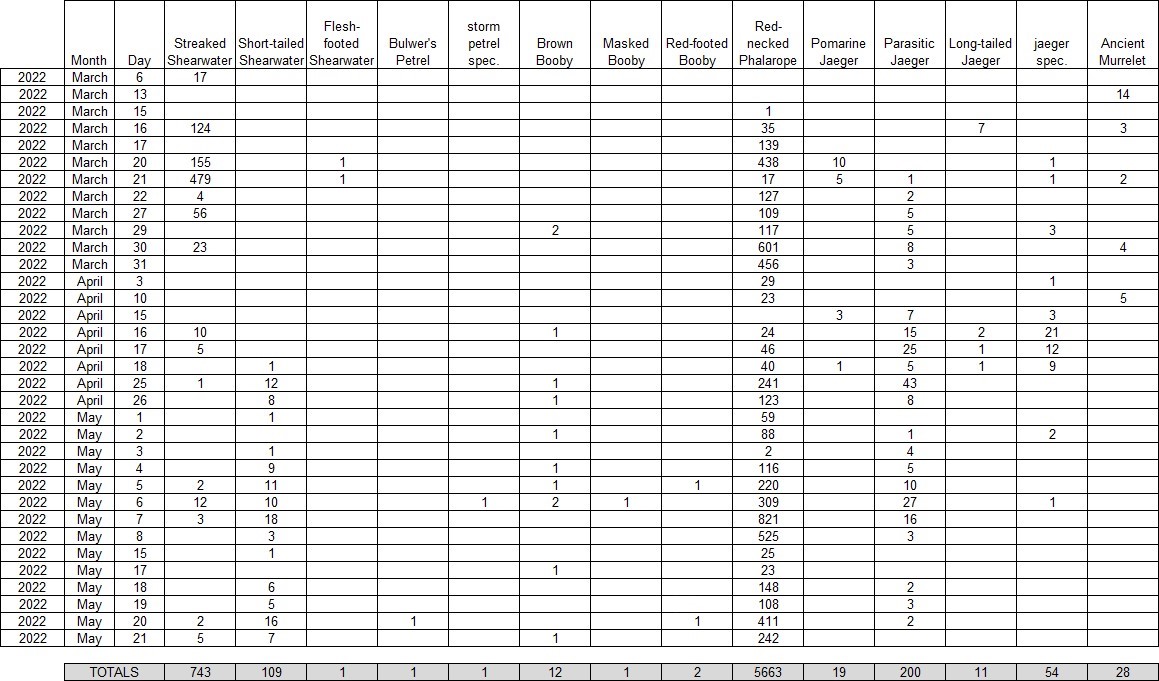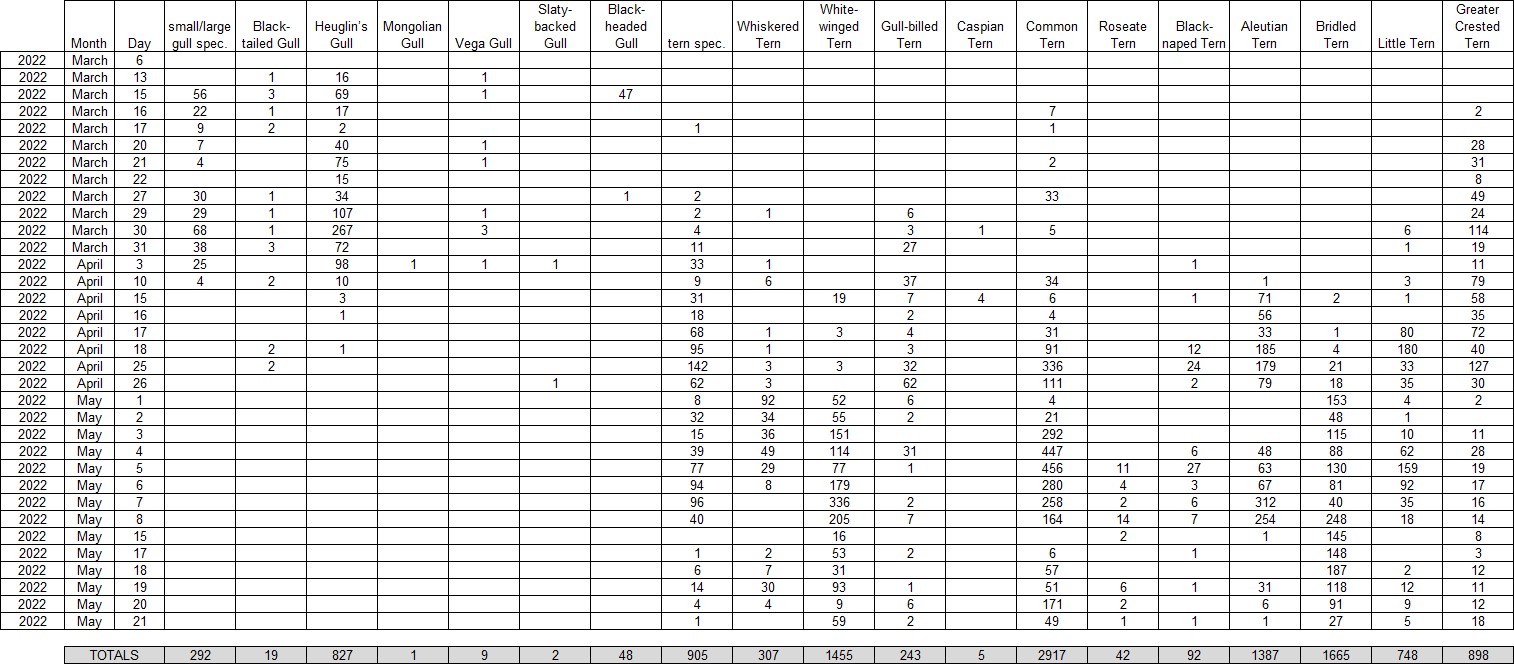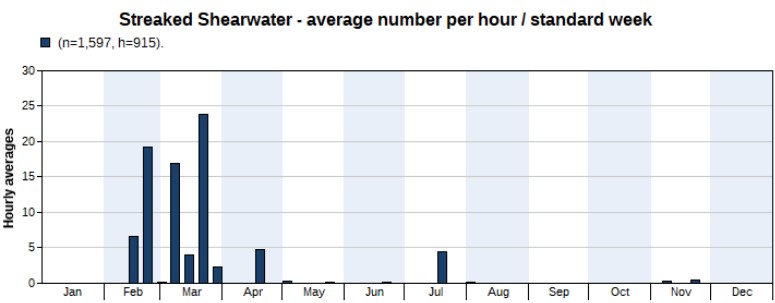Summary of spring 2022
This is an overview of all (migrating) seabirds and all (migrating) terns and gulls seen during the spring (i.e. March, April and May) of 2022. Below are the totals for the whole season.




Note that I’ve adjusted the total count for Streaked Shearwater, as the 155 birds counted on 20 March might all still have been around on 21st, so they are subtracted from the count to limit the chance of a double count. Same for the Flesh-footed Shearwater, which was the same bird on two consecutive days.
Let’s go over the most noticeable species/numbers, with some additional comments.
(1) After more than 200 Streaked Shearwaters last February, 743 were counted in spring.
First, this should be the best year ever – and by far – for this species in Hong Kong. Doing regular surveys, including full days and having watched well over 400 hours this year, seem obvious reasons for the increase. But there could well be other reasons, as over a hundred were seen from the ferry by birders this year, and that had never happened before either.
Second, February and especially March have been the best months for this species, very obviously, as this chart from Trektellen shows (counts for both 2021 and 2022).


(2) 109 Short-tailed Shearwaters were counted, maybe/likely the best spring ever for Hong Kong as well. But there were not much surprises here. It is known that most pass-by in May and we indeed saw the highest numbers (16 and 18) on days in May.
It’s a bird that can fly-by at any moment of the day, so it was not a surprise that the 18 on 7 May, during one of our full-time sessions, was a new high count for Hong Kong.
It seems that most pass-by on less windy days. Days with wind force 4 to 6 produced the lowest numbers of this species.
Note that we saw them into July last year, so it suggests that it is a very regular migrant from April to July, with good numbers by the end of April and a peak throughout May, and less regular with small numbers in June and July. But this too, should be the subject for yet further research and finetuning.
Alas, Trektellen uses pre-defined periods and April to July is not one of them. The below chart covers April to June for both 2021 and 2022. Note that the gaps between the bars are very often because there are no data available then, as there was no seawatching done. It is likely there were Short-tailed Shearwaters passing-by on e.g. 22 to 24 May, but nobody was there. And they could be more regular in June than the charts suggest, as well. Hope we can fill these gaps over the years; still so much to discover…


(3) The Flesh-footed Shearwater was the first record for Hong Kong and has been documented earlier in this thread.
(4) One certain Bulwer’s Petrel in the afternoon of 20 May was followed by a very likely second one towards the evening. The latter is not mentioned in the list.
Note that Robert Hackel and I also saw a Bulwer’s Petrel, coming from the Lema Channel, from a boat on 29 April. An interesting fact is that the weather on 29 April and 20 May was rather similar: light winds, calm sea, warm and sunny and the birds were both seen in the afternoon. Of course, this can be a coincidence. The main point that I take away from this, is that I’m happy to go seawatching in spring on warm, sunny days with little wind.
Both records, and the ones seen last autumn, further indicate that this is an annual visitor to Hong Kong waters. There is not enough data to conclude if there are particular peaks in the year (but likely mainly in spring and in autumn), but broadly speaking, April to October is presumably a period in which they can be seen.
(5) The one storm petrel could alas not be identified to species. It should be Swinhoe’s, but some other species cannot safely be excluded, as the bird was not seen in flight. Nonetheless, it is interesting data, which may indicate that Swinhoe’s is less likely to be seen in spring and (much?) more likely in late summer/autumn (August to October). I mean that the absence, apart from this possible bird, is as much indicative as its presence would have been. We hope we can add some more data of this species in the coming autumn to get a better understanding of the peak season in Hong Kong for this seabird.
(6) No less than 12 Brown Boobies were seen this spring. Note that there are 13 records of this species in all the years prior to 2021. Usually one per year, with the exception of 2009 (3). This species was also not recorded in 2011 to 2016.
We encountered two together on 29 March and 6 May. I know of at least one certain sighting from a boat this spring by Martin Williams and at least one possible one from the ferry.
Additionally, we saw 3 in total in the summer of last year. But it looks likely to be a regular spring migrant, though mostly singles on a given day.
(7) The Masked Booby on 6 May is the second record for Hong Kong, if accepted. The previous one, an immature, was also seen from Po Toi, on 18 March 2008.
(8) Red-necked Phalaropes were seen on all except 3 days (6 and 13 March and 15 April). High counts of 601 on 30 March and 821 on 7 May are noteworthy. Certainly the high count in May is, based on what we know from the past, rather exceptional, as high numbers usually occur earlier in spring.
(9) 200 Parasitic Jaegers this spring is perhaps yet another historically high count for any year in Hong Kong. A record high number of 43 was seen on 25 April and discussed in a previous post.
(10) We encountered 28 Ancient Murrelets in spring, including a record high count for Hong Kong of 14 on 13 March. We actually saw 50 in January and February, making it more of a winter visitor/migrant (but none were seen in December 2021) than a spring visitor/migrant, based on our data so far.
(11) 827 Heuglin’s Gulls were counted in spring, and 997 in both the 2022 first winter period and spring. March is clearly the top month for this (sub)species and much fewer were seen in April, although we didn’t perform that many surveys during that month, as you know. Our highest count this spring was 267 on 30 March.
(12) As can be seen from the above tables, terns were the most common birds this spring. That was also the case last summer (August) and autumn (September). From high to low, the most numerous this spring were Common Tern (2,917), Bridled Tern (1,665), White-winged Tern (1,455) and Aleutian Tern (1,387). But 898 Greater Crested Terns and 748 Little Terns are not bad either.
The highest numbers, of mainly Common Tern, were noted in early May. The best days for this species were 4 and 5 May with resp. 447 and 456. These were the highest counts for Hong Kong this century. Although it would always be good to double check in the future, we believe these are normal numbers for this species in spring.
We thought we could perhaps count a record high number of Greater Crested Terns, but due to a lack of full days in April, this goal was not reached. But 127 on 25 April (precisely the only full day of the month) and 114 on 30 March were noteless the second and third highest count for Hong Kong; the record of 165 was on 10 September 2021.
A much anticipated species we were on the lookout for, Chinese Crested Tern, was not seen. That is not so unusual, as it is of course a very rare bird anywhere. I saw some crested terns in the second half of March that I’d love to see a bit closer during a future survey. I believe Chinese Crested is likely to pass Hong Kong, but perhaps it will only be a few at most. Checking every crested tern is what we must continue to do…
[
Last edited by badesc at 9/07/2022 10:22 ]


